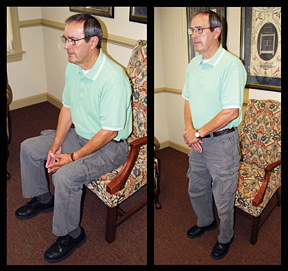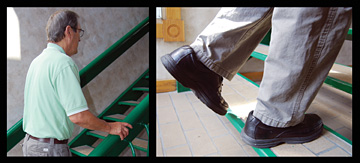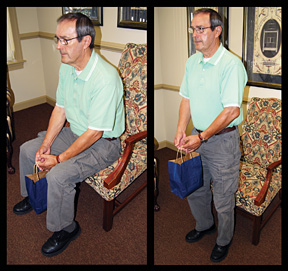Many people, particularly older individuals and those who have suffered an injury, experience difficulty going up and down stairs. In some instances, the difficulties are so significant that activities involving the use of stairs are completely avoided. This is true particularly when an alternate route (elevator, escalator or ramp) is not available.
There are several reasons why stairs can be a challenge. Among these are problems with joints of the hips, knees, ankles and feet. Heart, lung and blood pressure problems can also contribute, as can conditions that affect balance.
Another common problem, one that is sometimes overlooked, is weak leg muscles. Muscular weakness due to inactivity and the natural loss of muscle mass that occurs with age can be detrimental. The combination decreases the ability to go up and down stairs, and can affect other daily activities.
We all generally slow down with age. Daily activities decrease resulting in less movement and exercise. Age also brings a loss of muscle mass and strength. Typically, 10 percent of muscle mass is lost per decade after age 40. The good news is that this can be reversed significantly. Multiple studies in the past decade have shown that muscle strength and muscle mass can be regained even at advanced ages.
Are You Losing Leg Strength?
To determine if the difficulties are related to loss of strength, a simple test can be performed. Before performing the test, it is recommended that approval and/or supervision of a doctor or another qualified health care provider be obtained. This is especially necessary for heart, lung, and blood pressure patients, as dizziness may occur during the test.
 Figure 1 A-BA sturdy chair or bench is needed for the test. The chair or bench should be placed next to a rail or another sturdy object to hold onto if necessary. Always have something sturdy to hold onto for the test and for the exercises that follow.
Figure 1 A-BA sturdy chair or bench is needed for the test. The chair or bench should be placed next to a rail or another sturdy object to hold onto if necessary. Always have something sturdy to hold onto for the test and for the exercises that follow.
The test involves repeatedly moving from a seated to a standing position. (Figure 1 A-B) A person under the age of 50 should be able to stand from a seated position 10 times in a row in 20 seconds or less. A person over age 50 should be able to perform the same task in 25 seconds or less.
The test sounds easy, but a substantial number of people in both age groups fail. Pass or fail, the next steps are to either maintain the ability to pass the test or to work toward the ability to pass. These goals can be addressed with a few simpleexercises.
Easy Exercises to Put the Spring Back in Your Step
 Figure 2 A-BThe first exercise is to step up and down on a single step. This can be performed using the lowest step in a staircase. Use the handrail for stabilization and balance. (Figure 2 A-B) The exercise is performed by stepping up and down with one leg. The leg used to step up is also the leg used to step down.
Figure 2 A-BThe first exercise is to step up and down on a single step. This can be performed using the lowest step in a staircase. Use the handrail for stabilization and balance. (Figure 2 A-B) The exercise is performed by stepping up and down with one leg. The leg used to step up is also the leg used to step down.
Perform the exercise 10 times; then repeat with the opposite leg. Additional repetitions can be added as strength improves. Additional steps should be added gradually (two to three repetitions per week) until 30 repetitions can be performed with each leg. The exercise should be performed daily if possible.
The next exercise is to use the test itself as an exercise. Moving at a steady but not strenuous pace, stand from a seated position 10 times in a row. Repeat two more times (30 total repetitions). It is not necessary to time the exercise.
 Figure 3 A-B
Figure 3 A-B